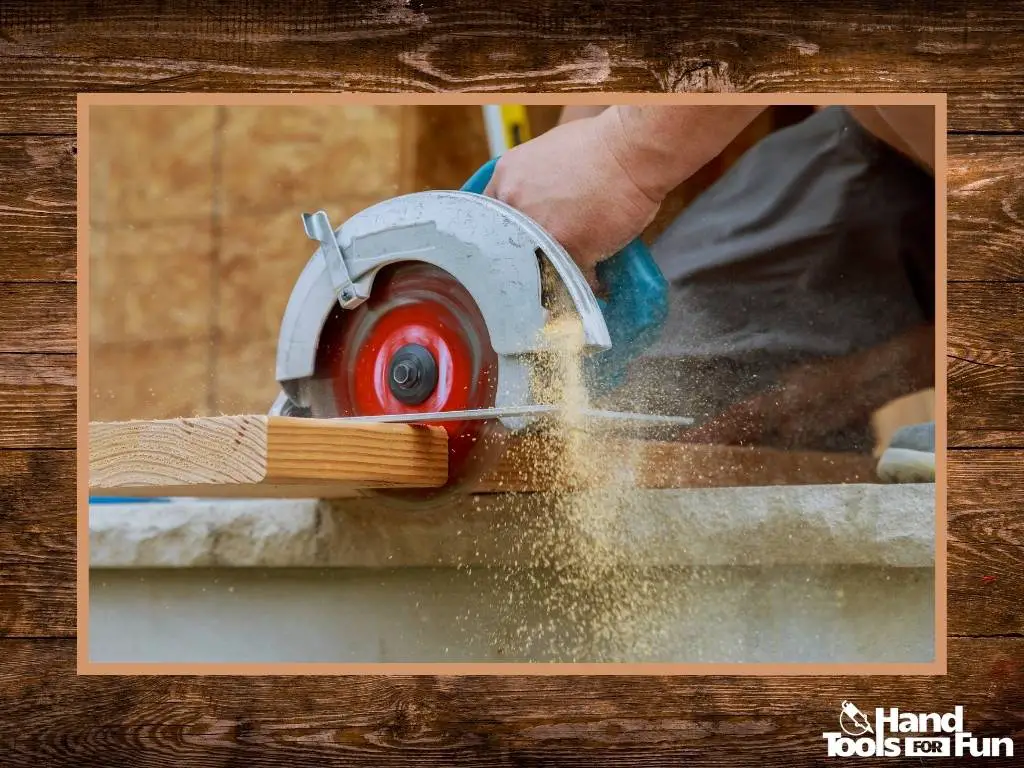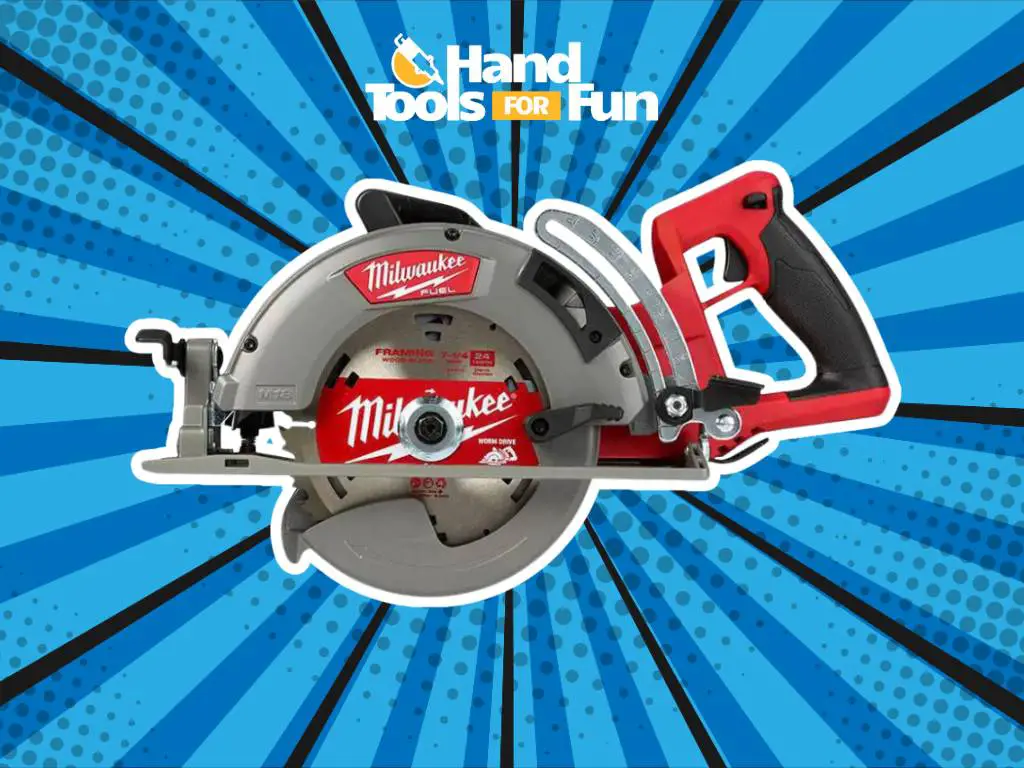When it comes to power tools, worm drive saws stand out as a preferred choice for many professionals and enthusiasts alike.
Notably, these saws feature a distinctive design where the motor is in line with the blade, a configuration that offers high torque for tough cutting jobs.
One of the most interesting aspects of worm drive saws is their left-handed blade placement, which is integral to both visibility and safety during operation.
This introduction delves into the nuances of worm drive saws, highlighting the design elements that provide a unique balance of power and precision, while also underscoring the importance of ergonomics for the user.
With a focus on the left-hand orientation of the blade, we step into a detailed discussion on how it significantly enhances the workflow, especially for right-handed users, as it ensures a clear line of sight and keeps the hands at a safe distance from the cut, thereby reshaping our approach to these robust tools.
Understanding Worm Drive Saws

The Unrivaled Precision of Worm Drive Saws for Woodworking Enthusiasts
Body:
Hey there, fellow woodworkers and sawdust savants! Let’s cut right to the chase: worm drive saws are in a league of their own, and there’s some serious saw speak to be had about what sets these powerful tools apart from the classic circular saws you might have buzzing around your workshop.
First off, it’s all about torque and power. Worm drive saws flaunt their muscle through a beefy worm gear transmission that delivers more torque to the blade than a typical sidewinder saw.
This means smoother, more controlled cuts even through the toughest lumber. You’ll appreciate that extra oomph when you’re slicing through wet wood or plowing through engineered materials like plywood or dense particleboard.
Then there’s the line of sight. Worm drive saws are designed with the blade on the left side – that’s a game-changer for right-handed users.
The improved visibility of the cut line ensures precision is a cut above the rest. Lefties, fear not, this configuration is still a clear shot for accurate cutting, with a little practice.
Balance and control come next. Thanks to their elongated design, worm drive saws offer a steadier and farther-reaching support base.
During operation, this means enhanced balance and a stunning reduction in fatigue. Say goodbye to wobbly lines and hello to clean, straight cuts, even on a project’s home stretch.
Now for the showdown on durability. There’s no denying that worm drive saws are built tough. Their construction is solid, often with hardy materials and motors engineered for longevity.
Sidewinder saws have their merits, but for a tool that feels like it’s forged from the fires of Hephaestus himself, a worm drive saw is the kit to reach for.
Last but not least, let’s talk about depth and angles. The design of worm drive saws typically allows for greater cut depth and more intricate bevel adjustments.
This means versatility takes a front seat, offering a treasure trove of options, from deep rabbet cuts to intricate angled joints.
For the craftsperson who covets depth and complexity in their work, nothing compares to the adaptability of a worm drive saw.
While heavier than their sidewinder counterparts, the worm drive saw is a testament to the adage “with great power comes great responsibility.”
It requires a certain respect for the tool, an acknowledgment of its capability, and a commitment to mastering its potential.
So, whether you’re a seasoned carpenter or a hobbyist eager to elevate your woodworking game, worm drive saws are a cut above, offering exceptional control, undeniable power, and the precision needed to turn any woodworking project from good to outstanding.
Keep it true, keep it straight, and let the sawdust fly with confidence when a worm drive saw is in your hands.
Ergonomics and Safety
Diving further into the intricacies of worm drive saws, another critical aspect to explore is how their left-handed design significantly enhances safety and ergonomics for users.
This detail may seem minor at first glance but can make a world of difference when it comes to ease of use and reducing the risks of accidents.
One of the primary safety benefits of a left-handed design in worm drive saws lies in the positioning of the blade.
With the blade placed on the left side, right-handed users, who make up the majority, hold the main handle with their stronger hand.
This not only allows for a firmer grip but also positions their body in such a way that they’re less likely to lean over the saw to watch the cutting line.
As a result, inadvertent kickbacks — a common and dangerous occurrence when a saw binds, stalls, or encounters an obstacle — are less likely to direct the saw towards the operator.
Moreover, the left-handed design helps in reducing the obscurity created by sawdust. As the blade tears through the material, sawdust is ejected, which can obscure the cutting line.
However, being on the side opposite to the blade allows for a cleaner sight since the body of the saw itself blocks less of the user’s view.
This clear line of sight isn’t just about precision—it’s a vital facet of safety, ensuring that cuts are predictable and controlled.
Ergonomically, the left-side blade translates to reduced fatigue and strain. When you’re guiding a worm drive saw, the motor and the bulk of the weight are situated behind the blade, creating a pivot point around which the saw can swivel.
For right-handed users, guiding the saw becomes more intuitive with the left-handed design, allowing for a cut that’s not just accurate, but also less physically demanding.
Lastly, the distribution of weight in left-handed worm drive saws caters to natural hand dominance.
Right-handers can use their dominant hand to manage the main handle and trigger, providing strength where it’s needed most and allowing the other hand to merely guide and stabilize.
This distribution of labor between hands reduces overexertion, thereby enhancing overall control and reducing the chance of mishaps due to user fatigue.
All of these factors combined showcase how the left-handed design of worm drive saws doesn’t just improve user experience but ingrains safety and ergonomics into the very operation of these powerful tools.
Whether you’re a seasoned professional or an amateur enthusiast, appreciating these subtle yet significant design choices helps in achieving mastery and ensuring every cut is as safe as it is precise.
Operating Techniques
Embracing the Left-Handed Worm Drive Saw: Sharpen Your Skills with These Best Practices
When it comes to using left-handed worm drive saws effectively, a few best practices can ensure that every cut is precise and every project is a notch above the rest.
Let’s face the raw humming power of the saw and channel it with finesse for stellar results.
First, it’s essential to master the correct stance. With the left-handed saw, the blade is on the user’s left, meaning the weight distribution favors the right hand.
So, position your body to the left of the cut line, allowing a dominant right hand to guide the saw while maintaining a clear view. This should afford optimum balance and controlled movement throughout the cut.
Grip is another critical factor. Hold the saw with a firm, but not vice-like, grip. The front handle should be clasped with the left hand, providing stability and guidance, while the right hand takes charge of the rear handle and trigger. Such a grip keeps the saw steady against torque forces and allows for precise maneuvering.
Saw blades are among the most crucial aspects of a cut’s quality and the saw’s performance. Ensure that the blade is sharp and appropriate for the material being cut.
A dull blade can cause the saw to work harder, which not only affects the cut’s cleanliness but also increases the risk of kickback. Remember, a pristine blade translates to effortless cuts and a longer lifespan for the saw.
Setting the proper depth of the cut also deserves attention. Adjust the blade so it’s just about a quarter inch deeper than the material’s thickness.
Not only does this improve the saw’s efficiency, but it also minimizes the risk of kickback and blade pinching.

Speaking of pinch, be aware of material support. When cutting large sheets or long boards, support the material on both sides of the cut. This prevents sagging, which could pinch the blade and either stall the saw or elicit kickback.
Blade visibility is vital, and with a left-handed worm drive saw, maintaining a clear line of sight is intuitive. However, sawdust can still be a nuisance.
Use dust blowers or extraction systems if available, or periodically stop to clear debris for an unobstructed view and accurate cuts.
Always be mindful of the cord. It should trail behind you and the saw, away from the cutting path.
This not only prevents accidental cuts through the cord but also reduces the chance of tripping or entanglement.
Lastly, let’s not forget about starting and stopping the saw. Engage the saw at full speed before the blade touches the material and ensure the blade comes to a complete stop after the cut before lifting it away. Patience here is paramount for both safety and accuracy.
By integrating these practices into your workflow, you’ll elevate your craft with a left-handed worm drive saw.
Keep the focus on control, visibility, and blade maintenance, and every project will not just be a testament to power, but to precision and safety as well.
And before you know it, the left-handed worm drive saw will feel like an extension of your own steadfast hand, turning daunting projects into masterpieces with every graceful cut.
The journey into the world of worm drive saws reveals how a blend of strategic design and practical ergonomics can result in tools that are not only powerful but also user-friendly.
The intricate balance of motor alignment, torque delivery, and left-handed blade placement coalesce to provide an experience that caters to precision, visibility, and overall safety.
Grasping the operational techniques suited to the heft and might of these saws allows hobbyists and professionals to execute their work with an informed and skillful edge.
As we wrap up our discourse on worm drive saws, it becomes evident that the attention to detail in their design plays a crucial role in elevating the standards of saw performance and user experience, truly making them a pivotal asset in any craftsman’s arsenal.


